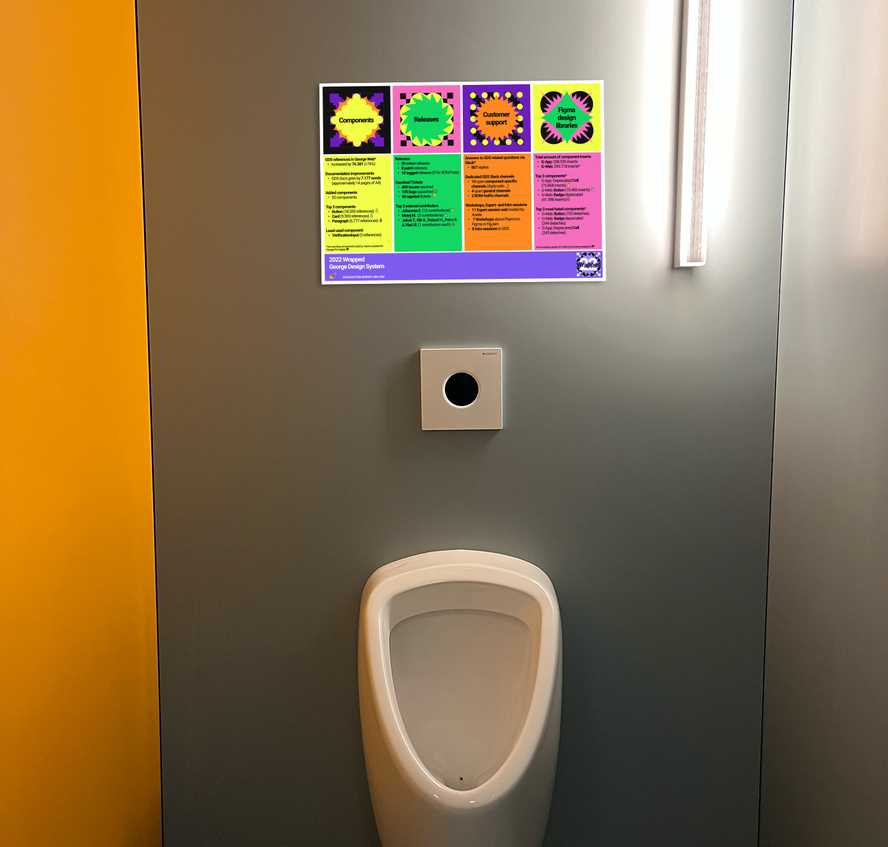Let's (not) talk numbers
Last year in December, our team came up with some kind of guerilla marketing – heavily inspired by Spotify wrapped – to internally promote and highlight some of the George Design System’s (GDS) achievements in 2022.

—A restroom at Erste Campus in December 2022.
While it was clear to us that we would not want to repeat the same in 2023, we still wanted to reflect on the team’s achievements this year as well.
This blog post is about my struggle to report on numbers (although there would be plenty worth highlighting). I will try to outline why this task is challenging and why I – for now – gave up on it; bear with me.
To not completely fail in this, I present three numbers to you:
1.691.941, 100.006 and 8
Before I put these numbers in context, I’ll explain a bit about the reasons for my struggles writing this article. Not interested? TLDR? Click here.
Like any design system, the GDS is a grown and living product. Within George-Labs, we understand a design system as follows:
A design system is a collection of reusable components (design libraries and code), guided by clear rules, that can be assembled to build any number of applications. The coded components are the single sources of truth to allow multidisciplinary teams to envision and develop products.
As clear and simple as this definition is, as complex, cluttered and distributed are the responsibilities behind the GDS – grown and organic like the teams that build George; the GDS consists of four different universes:
- George in the browser (Web), Playroom and Storybook
- George in the apps (Android and iOS)
- George Store
- External applications
Distributed ownership and responsibilities
For each universe, a different group of people is responsible – and this can range from a single person to a dedicated team.
Shipping a feature, doing a redesign or – more generally speaking – success almost never happens as a one-person show. It is usually a group effort and only possible through the hard work of many. This is equally true when talking about a design system.
Like with any living product, there are even more roles and teams that help to shape the GDS: designers who challenge the status quo and come up with new and exciting features – sometimes to be called back to not go fully overboard; developers who are working with the GDS on a daily basis and file tickets for improvements; testers and some more.
Fragmented, partially unknown consumers
As fragmented as the teams are that together build a great product, documented under the umbrella of this very website, are the consumers of the GDS.
For George in the browser, obviously the George frontend core team is the main consumer, but there is a constantly growing number of teams within and even outside Erste Group, that make use of the GDS to build products that we, who develop, improve and maintain the GDS, might not have access to and do not see while getting developed or finally launched.
This makes it obvious why it is not easy to report representative numbers.
And one final thought: Some exciting things my team has been working on during 2023 (dark mode, design tokens, central asset repository) will continue and be released in 2024. So, why report numbers on these now, just because a year comes to an end?
But let’s circle back to the beginning of this article and reveal the meaning behind the three numbers.
TLDR;
For the climatic effect let’s start with the lowest number:
8 is the total amount of commits in 2023 from the number one external contributor to the GDS documentation. – Kudos to Mike G. from the Android chapter. 🥇
100.006 is the number of GDS React component instances the George FE Web chapter has added to the code of George in 2023 (by the time of writing this article).
1.691.941 is the number of GDS Figma design component instances (G-Web and G-App) that have been added to design files in 2023 over the entire Erste Group.
But let us not talk about numbers, let’s continue to build a great product together.